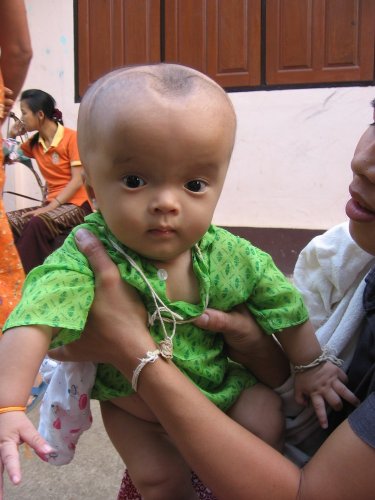Neurological Conditions

“Htein Linn” – 2yrs (post-op)
- Hydrocephalus is a condition in which there is excessive accumulation of fluid in the brain. Although hydrocephalus was once known as “water on the brain,” the “water” is actually cerebrospinal fluid (CSF) — a clear fluid that surrounds the brain and spinal cord. The excessive accumulation of fluid creates potentially harmful pressure on the tissues of the brain. In infants, the most obvious indication of hydrocephalus is a rapid increase in head circumference or an unusually large head size. Other symptoms may include vomiting, sleepiness, irritability, downward deviation of the eyes, and seizures. Hydrocephalus is most often treated by surgically inserting a shunt or tube which diverts the flow of CSF to another area of the body where it can be absorbed as part of the normal circulatory process.
- Spina Bifida, which literally means “cleft spine,” is characterized by the incomplete development of the brain, spinal cord, and/or meninges (the protective covering around the brain and spinal cord). Spina Bifida happens when a baby is in the womb and the spinal column does not close all of the way. Surgery may be required to correct the spinal defect. Additional treatments may depend on the type and degree of complications. For example, patients may suffer from nerve damage that causes co-occurring urinary incontinence. These patients may require catheterization. Two types of Spina Bifida are:
- Myelomeningocele is the most serious type of Spina Bifida. With this condition, a sac of fluid comes through an opening in the baby’s back. Part of the spinal cord and nerves are in this sac and are damaged. This type of Spina Bifida causes moderate to severe disabilities, such as problems affecting how the person goes to the bathroom, loss of feeling in the person’s legs or feet, and not being able to move the legs.
- Meningocele is another type of spina bifida. With Meningocele, a sac of fluid comes through an opening in the baby’s back. But, the spinal cord is not in this sac. There is usually little or no nerve damage. This type of spina bifida can cause minor disabilities.
- Encephaloceles are neural tube defects where brain membranes protrude through openings in the skull. Encephaloceles cause a groove down the middle of the skull, between the forehead and nose or on the back of the skull. Encephaloceles of the back of the head are more common in Europe and North America, while encephaloceles on the front of the head more frequently occur in Southeast Asia, Africa, Malaysia and Russia.


